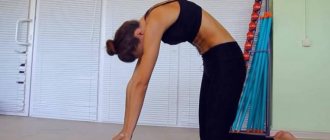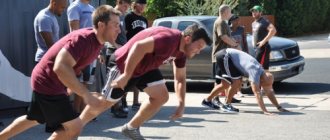Terms of use
If you twist the rope in pairs for the third child, the rope should be much longer, but for an individual lesson you need to adhere to the following rule - the length of the rope needs to be adjusted so that when you stand with your feet in the middle of the cord, the handles reach your armpits.
The basic rules of use are as follows:
- When doing a set of exercises, you need to hold the rope with your fingers, palms facing forward, at the beginning of the jumps the cord should hang in front of your feet;
- holding the handles freely, but the fingers are tightly closed so that the handle does not break out;
- when rotating, the hands should be slightly bent, the elbows should look down, the shoulders should move just enough to ensure that the movements are supported and not actively assisted;
- When performing a complex with a jump rope, you need to maintain correct posture, your back should be straight, this has a positive effect on the muscles and breathing, which should be free;
- you need to try to jump as softly as possible, before you step on your feet, you need to put your foot on your toes, this helps strengthen your legs and also prevents them from getting tired quickly;
- Hitting with a jump rope is painful, and being hit with a jump rope handle can cause injury, so keeping a safe distance away from the rope being fully extended is very important.
How to choose a jump rope for training
If you decide to start jumping rope to lose weight or train your heart, then it’s time to think about which jump rope to choose? The fitness equipment market offers a large selection of jump ropes with different functionality.
1) Simple jump ropes
This is the most ordinary jump rope that has been familiar to us since childhood. There will be no additional functions or features here. The price of such a jump rope is quite small, so it is suitable for those who still have doubts about purchasing a jump rope or for those who just want to jump “without any hassles.”
The material used to make the cord and handle of a jump rope can be completely different. And its price will largely depend on this. Some jump ropes come with an adjustable length, which is especially important if you are purchasing a jump rope for the whole family.
2) Jump ropes with built-in counter
These jump ropes have a special counter built into the handles, which counts the number of rotations, and therefore the number of jumps made. Jump ropes with a built-in counter are incredibly convenient for tracking progress in exercise and recording results.
You will know exactly how many jumps you have made. You don't need to set a stopwatch or count the number of jumps manually, all data will be recorded. There are also jump ropes with an electronic counter, which can additionally display the duration of the jumping session and the number of calories burned.
3) Speed jumping ropes
But this type of jump rope is ideal for losing weight. Due to the high rotation speed, you will make more revolutions, which means you will train even more effectively. When performing exercises with a high-speed rope, professionals can reach a rotation speed of up to 5-6 revolutions per second! The length of such jump ropes is usually adjustable.
Speed jumping ropes are not suitable for performing complex exercises (jumps with crossed arms, double jumps, etc.). But such jump ropes will appeal to those who like to engage in intense training. By the way, jumping with speed ropes is very popular in CrossFit, and this says a lot.
4) Weighted jump ropes
And another improved version of this fitness equipment is a weighted jump rope. The weight of such jump ropes will be significantly higher compared to other analogues. The jump rope is made heavier by adding weight to the handles or to the weight of the cord. The weight of such jump ropes can even reach three kilograms. In some models, the weight can be adjusted by the practitioner himself.
Weighted jump ropes are more suitable for experienced practitioners who do not have enough load with a regular jump rope. And also for those who want to additionally load the muscles of the upper body.
5) Leather jump ropes
In a leather jump rope, the cord is made of leather. What is special about such jump ropes? By reducing the weight of the cord and increasing the weight of the handle, a specific load is placed on the muscles of the upper body.
When the jump rope cord is light in weight, it rotates more slowly. Therefore, to increase the rotation speed, more effort has to be applied. In this case, the main load falls on the shoulder girdle. Such jump ropes are popular even among professional athletes, for example, among boxers.
Jumping and games
A set of jumping and play movements with a skipping rope:
- Regular forward rotational movements of the rope with jumping on two legs.
- Jumping on one leg.
- When jumping, move one leg forward and the other behind.
- Jump on one leg at a time.
- Rotate the rope backwards, jump on two and one leg.
- Cross your legs and rotate the rope forward.
- Stepping over a skipping rope.
- Cross your arms every other time.
- Advancement by jumping forward.
- Jump together, in a position one after the other or side by side, in the second case, the ends are held by two children in the outer hands.
- Jumping over a long rope held by two children. Several children can jump, as long as the rope is long enough.
- One child spins the rope, the others jump over, and whoever touches is eliminated.
- The complex may also include other games and competitions, for example, how many children can jump over a long rope at the same time.
Jumping rope of varying durations on one and two legs on limited support
Physical exercises should be carried out in well-ventilated areas. It is very beneficial to do exercises outdoors.
When conducting classes, it is mandatory to have a first aid kit. Strictly follow the basic methodological rules: gradually increase physical activity during classes, but by the end of classes bring the loaded body to a normal state. Constantly remember and ensure that the physical activity in classes corresponds to the physical capabilities of the students.
The following rules must be observed:
– increase the duration and load of classes gradually;
– before starting the exercises, do a warm-up, including slow running (3-5 minutes), general developmental exercises and exercises for those muscle groups that take the greatest load in this exercise;
– comply with all safety rules, paying attention to the suitability of shoes, equipment, evenness of the site surface, and other requirements.
General strengthening of the body
I. p. (starting position) legs apart, arms to the sides. Sharply pull your arms back and into the I.p. I.p. legs apart, arms up. We make circles with both hands inward and outward (alternately) in the front plane (in front of us). I. p. legs apart, right hand up, left hand down, back. Change the position of your hands with sharp swings.
Rotate your head in the largest circle possible for you in one direction or the other.
Quickly and relaxedly turn your head left and right, trying to look as far behind your back as possible. After this, tilt up and down.
I.p. legs apart, arms forward. Lean forward. Touch the floor with your palm and return to the starting position.
I. p. legs apart, hands on the belt. Tilt to the right, straighten up, then do the same to the left.
I. p. legs apart, hands on the belt. Bend back, bending at the lumbar spine. Return to starting position.
I. p. legs apart, hands on the belt. Circular movements of the body to the right and left.
I.p. stand up, legs together. Squat without lifting your heels from the floor. Spring squats.
I.p. kneel down, pull up your socks, put your hands on your belt. Sit on your heels, then return to the starting position.
I.p. standing on your left leg close to the support, bend your right leg back and grab your shin with both hands from behind.
I.p. walk a few meters on the outside of the feet.
I.p. walk a few steps on pointed toes.
Mastery of basic motor and applied skills and their improvement.
The exercises are performed as part of a group (guard), each exercise is performed for 2-3 minutes, then rest for 1-2 minutes. Before starting the exercises, the leader of the lesson or the most prepared employee appointed from among the l/s group (guard) shows the procedure for performing jumping rope:
- Get ready: the jump rope is at the back. Extend your arms in front of you to fully straighten the rope.
- Take the starting position: stand straight, legs together, look straight ahead. The arms are slightly bent at the elbows, the hands are spread to the sides at a distance of 15–20 cm from the hips. Then start rotating the rope
- Rotation of the rope: making small rotational movements with your hands, begin to rotate the rope (from below behind your back - up, above your head - forward and down under your feet), while your hands should remain almost motionless. Moving your arms too widely is a mistake. Try to keep your hands as close to your body as possible.
- Jumping: Push off from your toes and land softly on your toes and balls of your feet, keeping your heels off the floor. Jump low, a couple of centimeters maximum, this is enough so as not to interfere with the rotation of the rope. When passing under your feet, the rope should lightly touch the floor so that the rhythm does not slow down.
The beginning of the exercises, the commands given: “Starting position - ACCEPT!” and then to perform the exercise “Exercise start-NAY!”
– Exercise No. 1 with a skipping rope – single jumps:
Take the starting position, slowly begin to rotate the rope and jump, pushing off with your toes. When landing, bend your knees slightly. One revolution should correspond to one bounce. Then gradually speed up the pace of jumping.
– Exercise No. 2 with a skipping rope – jumping with alternating legs:
Take the starting position. Jumping in this exercise is performed on each leg alternately, like running in place. A fast pace for performing this exercise is optimal.
– Exercise No. 3 with a skipping rope – double jumps:
This exercise is performed similarly to exercise No. 1, however, there should be two jumps per revolution of the rope. Jumping in this exercise is performed at a slow pace, which allows you to restore your breathing.
– Exercise No. 4 with a skipping rope – jumping to the sides:
This exercise is performed similarly to exercise No. 1, only you need to jump to the sides, alternately first to the right, then to the left.
– Exercise No. 5 with a skipping rope – jumping back and forth
Jumps in this exercise are performed alternately forward and backward.
Development and continuous improvement of physical strength and endurance, strengthening health and increasing the overall performance of the body.
Acquiring skills and abilities, physical and mental qualities that contribute to the successful performance by personnel of their official duties and maintaining high performance.
Bringing the body into a relatively calm state.
Slow walking and deep breathing exercises:
- ex. 1 – stand on your toes, simultaneously raise your arms to the sides and further up – inhale; lower your entire foot, arms down – exhale.
- ex. 2 – stand on your toes, simultaneously raise your arms to the sides with your palms up – inhale; lower your entire foot with your torso tilted forward, cross your relaxed arms in front of your chest – exhale.
Both exercises are performed in place and in motion.
Exercises
A set of exercises with a skipping rope:
- Raise the rope folded four times over your head, bending backwards and placing one foot to the side on your toes.
- Hold the rope folded four times down behind your back, bend forward, lowering your arms to the middle of your shins and do 3 bends with springs, try to touch your chest with your legs.
- Raise one leg in the air, pulling the jump rope with your foot, and hold for a few seconds, maintaining your balance.
- Lie on your back, pull the rope with straight legs and do rolls on your back.
- Jump rope in half squats and squats.
These exercises can be used as a preparatory complex when moving on to more complex movements with a skipping rope, which can be done to music. With schoolchildren, you can do a complex group performance, in which several children can jump over a skipping rope and do semi-acrobatic tricks with a skipping rope. If you take an integrated approach - combining gymnastics, acrobatics with jump rope exercises, you can create an interesting choreographic performance.








